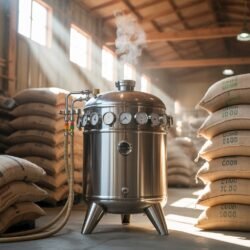If you’ve ever sipped a cup of anaerobically fermented coffee, you know it’s a wild ride for the senses. These beans are famous for their explosive fruitiness, wine-like acidity, and layers of unexpected flavors that set them apart from your everyday brew. But when it comes to roasting, not all profiles are created equal. In fact, dark roasting these unique coffees can actually do more harm than good. Let’s dive into why that is—and what you should look for instead.
The Magic of Anaerobic Fermentation
Before we talk about roasting, it’s worth revisiting what makes anaerobically fermented coffee so special. This processing method involves sealing coffee cherries in airtight tanks, where they ferment without oxygen. The controlled environment encourages specific microbes to break down sugars and acids, resulting in a flavor profile that’s bursting with tropical fruit, berry, floral, and even boozy notes. The acidity is often bright and wine-like, and the sweetness is pronounced, making each sip a complex, layered experience.
Because of this unique fermentation process, anaerobically processed beans are packed with delicate aromatics and flavor compounds that are easily lost or altered if not handled carefully during roasting.
What Happens During a Dark Roast?
Dark roasting is all about intensity—high temperatures and long roasting times that bring out deep, smoky, and sometimes bitter flavors. At this stage, the beans develop oils on their surface, and the sugars inside caramelize further, sometimes even charring. The result is a cup that’s bold, rich, and often dominated by roast characteristics like chocolate, smoke, or even a hint of ash.
While dark roast can be delicious for certain types of coffee, it’s a double-edged sword for more delicate or complex beans. The high heat and extended roast time can burn off or mask the subtle, nuanced flavors that make anaerobically fermented coffee so exciting.
Why Dark Roast and Anaerobic Coffee Don’t Mix
1. Flavor Masking
The most obvious issue is that dark roast flavors—think smokiness, bitterness, and char—can easily overwhelm the delicate fruit, floral, and wine notes that anaerobic processing creates. Instead of tasting pineapple, mango, or berry, you might end up with a cup that’s dominated by roastiness, leaving little room for the coffee’s inherent complexity to shine.
2. Loss of Acidity and Sweetness
Anaerobic coffees are prized for their vibrant acidity and lingering sweetness. Dark roasting tends to mellow out acidity and can even introduce bitterness, which clashes with the natural sweetness of the beans. The result is a cup that feels flat or unbalanced, missing the bright, lively character that makes these coffees so memorable.
3. Fragility of the Beans
Anaerobic fermentation can make the beans more porous or fragile, as the prolonged fermentation process breaks down some of the cell structures. This makes them more susceptible to scorching or uneven roasting at high temperatures. Dark roasting can lead to burnt or uneven flavors, further diminishing the quality of the final cup.
4. Wasted Potential
Perhaps the biggest reason to avoid dark roast with anaerobic coffee is simply that it wastes the potential of these special beans. The whole point of anaerobic fermentation is to create something unique and exciting—a coffee that stands out from the crowd. Roasting them dark is like painting over a masterpiece with a thick layer of black paint; you might still see the outline, but you’ll miss all the beautiful details.
What Roast Profile Works Best?
Most specialty roasters agree that lighter or medium roast profiles are the way to go with anaerobically fermented coffee. These gentler roasting methods preserve the delicate flavors and aromatics, allowing the coffee’s natural complexity to take center stage. You’ll get a cup that’s bright, juicy, and full of surprises—exactly what these beans were meant to be.
Some roasters even experiment with very light roasts, pushing the boundaries to highlight the most vibrant fruit and floral notes. The key is to find a balance that enhances the coffee’s unique characteristics without letting the roast itself become the star of the show.
Tips for Brewing at Home
If you’re lucky enough to get your hands on some anaerobically fermented coffee, here are a few tips to make the most of it:
- Choose a lighter or medium roast. This will help preserve the coffee’s unique flavors.
- Brew with care. Use methods like pour-over or Aeropress to highlight clarity and brightness.
- Experiment with water temperature. Slightly cooler water (around 90–93°C) can help keep flavors vibrant and prevent bitterness.
- Take notes. Anaerobic coffees are full of surprises, so pay attention to how different brewing methods and roast levels affect the cup.
The Bottom Line
Anaerobically fermented coffee is a rare and exciting treat, offering flavors you won’t find anywhere else. To truly appreciate what these beans have to offer, it’s best to avoid dark roast profiles that can mask or destroy their delicate complexity. Instead, opt for lighter or medium roasts that let the coffee’s natural brilliance shine through. Your taste buds will thank you!


